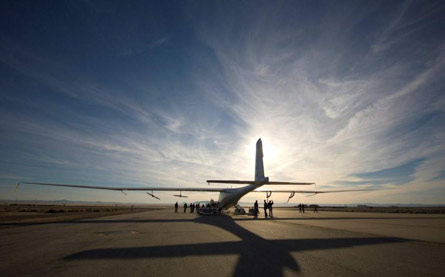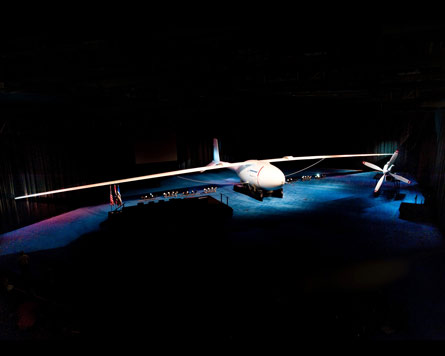Within the next year, two similar designs made by rival manufacturers will attempt to break the record for long-endurance flight by a high-altitude piston-powered aircraft and help establish a new class of flying vehicles aiming to perform a job now reserved for satellites.
As far as unmanned aircraft systems have come in the past decade, the emerging race to satisfy the US military's demand for unblinking sensor and communications relay coverage over vast areas will push designs and technology for unmanned aircraft even further.
Leading the quest are two rival designs so advanced that they have been in development and consumed hundreds of millions of dollars in investment over nearly a decade to reach this point.
 |
|---|
© US Air ForceThe Global Observer is designed to fly for at least seven days |
Both the AeroVironment Global Observer (GO) and the Boeing Phantom Eye scaled demonstrator are now poised to enter flight-testing before February, kicking off the race to set the next long-endurance flight record.
 |
|---|
© BoeingPhantom Eye, funded primarily by Boeing counts DARPA and NASA as supporters |
The immediate goal for the competing teams is to shatter that record held by the unmanned, gas-powered Boeing Condor and set in 1988 by circling over Moses Lake, Washington, at higher than 65,000ft (19,830m) for more than 59h.
By contrast, GO (pronounced "Geo") is designed to fly at least seven days, or nearly three times the endurance of the Condor standard.
The Phantom Eye demonstrator, smaller by 40% compared with the planned full-scale version, should fly 96h, or four days. At full scale, the Phantom Eye is designed to remain airborne for seven to 10 days.
In operations, such endurance could revolutionise the persistent surveillance mission. A system of two aircraft could establish a permanent orbit, with each aircraft alternating time on station in weekly cycles. From a vantage point above 65,000ft, the GO or Phantom Eye could stare up to 480km (260nm) in any direction. That is not a trivial distance in current operations. With a 965km coverage diameter, such aircraft see nearly the entirety of Afghanistan in a single 360º sweep of its sensor aperture or antenna. In another example, if either aircraft was perched above London, the area of coverage would extend from the eastern shore of Ireland to the western border of southern Germany.
Other aircraft in the US military's repertoire - notably the manned Lockheed U-2 and unmanned Northrop Grumman RQ-4 - already provide such coverage but at only a fraction of the endurance.
To deliver the next leap in endurance at such altitudes, both AeroVironment and Boeing have decided to boldly switch from fossil fuels to hydrogen as the source of power for each aircraft's piston engine. In both cases, hydrogen is burned as a gas but is stored on board the aircraft as a liquid.
The long-term viability of the Phantom Eye and GO concept may heavily depend on whether the aircraft makes can prove that such fuel is a practical alternative to petroleum.
As a fuel source, hydrogen has much to offer. As the most abundant gas in the universe, there is no shortage of raw material. Hydrogen offers three times the energy density of petroleum-based fuel, with a corresponding improvement in aircraft endurance. Finally, hydrogen is a clean source of power, leaving water as the only by-product after being burned.
Despite these advantages, it is not difficult to grasp why Boeing has never in its storied history attempted to power an aircraft with hydrogen. When stored as a liquid, hydrogen requires special insulation, as its boiling point is -253e_SDgrC (-423e_SDgrF). Besides the cryogenic cooling requirements, long-term storage and transport is also a problem. The liquid form of hydrogen evaporates at a rate of roughly 1% a day even when properly cooled.
In addition to the fuel challenges, an aircraft that continuously operates for a week or more poses no small new burden on the US military's already strained system for processing, exploiting and disseminating intelligence data. On the other hand, military officials are rushing as many new airborne intelligence assets as possible into Afghanistan.
Indeed, the US military's support for GO and Phantom Eye is strong and growing. Launched as a joint concept technology demonstration by US Special Operations Command in fiscal year 2008, GO now has six agency sponsors, including the US Coast Guard. Phantom Eye has been funded primarily by Boeing and industrial partners, but has the Defense Advanced Research Projects Agency (DARPA) and NASA as supporters.
To fight insurgencies in Afghanistan and Iraq over the past decade, military officials have demanded ever-increasing levels of unbroken surveillance across large areas. The 10h endurance of the human-limited U-2 fleet would continue to be used, but more capability was needed. Even the 35h-endurance provided by Northrop's jet-powered Global Hawk is unable to supply the persistence demanded by operators.
In the last few years, the Department of Defense has launched several experiments in a seemingly desperate attempt to fulfil demands for a surveillance capability that never blinks, but is cheaper to operate and easier to adapt or upgrade than an orbital satellite.
The various experiments cover a wide range of potential technologies, to include hydrogen- and solar-powered aircraft, as well as fixed-wing and airship approaches. GO and Phantom Eye fall into the category of hydrogen-powered, fixed-wing aircraft. DARPA's Vulture programme seeks to invent a solar-powered aircraft with endurance not measured in hours, days or even months, but years.
AIRSHIP TECHNOLOGY
Airship technology has also benefited from a revival of interest. Lockheed Martin is developing a lighter-than-air airship called Isis (integrated sensor is structure), which could remain on station for months to sweep the air and the ground for targets across hundreds of kilometres.
Meanwhile, the army has awarded a Northrop/Hybrid Air Vehicles team a contract to develop and deploy within 18 months a hybrid airship called the long-endurance multi-intelligence vehicle (LEMV), a medium-altitude surveillance aircraft that could be adapted in the future for airlift roles.
Each concept is seeking to overcome a wide range of challenges - technological, logistical and operational - that have prevented their widespread use over a century of powered flight history.
Compared with the DoD's alternative experiments, the GO and Phantom Eye offer obvious attractions. If the fuel source issues can be worked out, the concept is a direct extension - albeit with a radical change in endurance - of operations now performed by the U-2 and RQ-4. Compared with airships and five-year-long sorties by Vulture aircraft, the objectives of Phantom Eye and GO appear almost conventional.
The concept also has its followers. In the United Arab Emirates, for example, aerial target maker Adcom Systems has unveiled the SmartEye unmanned aircraft system, which is advertised to be seeking endurance up to 135h, or more than five days. However, there is no record that SmartEye has yet flown, although the company claimed the aircraft would be ready for first flight months ago.
As the trailblazer in high-altitude, unmanned flight, Northrop also clearly recognises the market's interest in even longer-duration flight than that of Global Hawk.
Although there are no public plans to boost the endurance of the RQ-4, Northrop is pursuing other options to extend the aircraft's range.
DARPA awarded a $33 million contract to Northrop in early July to demonstrate aerial refuelling for the Global Hawk fleet. Under the KQ-X concept, a probe-equipped RQ-4 will demonstrate passing fuel in flight to another Global Hawk equipped with a drogue.
The planned demonstration involving both NASA-owned RQ-4 Block 0 aircraft is intended to show that a single Global Hawk can remain in flight and on station as long as the operator wants. The challenge will be proving that aerial refuelling is feasible at very high altitudes.
Northrop's KC-X strategy was unveiled in the months leading up to the first flight of the GO and Phantom Eye, which is perhaps no accident. Briefing reporters in June, Boeing PhantomWorks president Darryl Davis bluntly predicted that Phantom Eye "will be less expensive than Global Hawk", although he offered no specifics.
AeroVironment, meanwhile, has republished on its web site a 2007 academic paper from the Naval Postgraduate School arguing that GO would be 77.7% cheaper to operate over its lifetime than the RQ-4.
FUEL CONSUMPTION
The key difference in cost between the two aircraft is fuel consumption, according to the paper. GO would burn 455kg (1,000lb) on each mission, compared with about 6,800kg for the jet-powered Global Hawk. At the same time, the GO mission would extend over several days, whereas Global Hawk would land within 24h. Although liquid hydrogen is far more expensive to buy, the fact that GO would burn far less fuel would generate huge cost savings compared with Global Hawk, the paper says.
Asked to respond, Northrop's analysts noted several flaws in the three-year-old paper's arguments.
Most notably, fuel cost represents only 1% of the operating cost for Global Hawk, with the balance spent on required systems and manpower that also must be spent on GO.
In addition, as a demonstration aircraft, GO is not designed to meet airworthiness standards. If GO becomes a programme of record, Northrop says, military officials will require such an aircraft to prove it can reliably operate in the national airspace, which will dramatically raise the cost of development.
Global Hawk is classified by the USAF as a "global reach" aircraft, meaning it must be able to self-deploy to any location. For the Global Hawk, that designation requires a unique level of airworthiness testing not applied to other unmanned aircraft, such as the General Atomics MQ-1 and MQ-9 Reaper. Given the GO's promised capabilities, Northrop's analysis would expect such an aircraft to meet similar standards if the programme moves beyond a demonstration.
Tim Conver, AeroVironment chief executive, chairman and president, explained Global Observer's possible uses in a teleconference call with market analysts on 24 June.
"We envision that initial applications for Global Observer will address many of the communication relays, and intelligence surveillance, and reconnaissance needs of the current sponsors," Conver said. "Other applications are likely to follow."
It is possible that both GO and Phantom Eye could find small niches in the diverse market for special mission platforms. The army's special forces appears to be interested in GO especially as a communications relay aircraft, eliminating the need to rely on expensive commercial satellite networks to transfer sometimes sensitive information.
Meanwhile, Boeing has pitched Phantom Eye as part of its portfolio of options for detecting missile launches. In a May presentation, a Boeing official's slide on Phantom Eye was titled "persistent [intelligence, surveillance and reconnaissance] enables early intercept".
As it stands, GO is scheduled to complete development and be available for demonstration uses by air force special operations command next year. AeroVironment has received about $120 million to deliver three aircraft for the joint concept technology demonstration.
AeroVironment moved the first airframe to Edwards AFB, California in May to complete ground tests while the second aircraft is in final assembly.
Boeing's PhantomWorks division appears to be trailing the activity of its rival by a few months. The company staged a roll-out of the Phantom Eye demonstrator in July. Notices posted inside the factory during a June tour indicated that first flight was scheduled for the week of 20 January.
The rival manufacturers have adopted the same type of engine, but took slightly different approaches. AeroVironment developed and qualified its own engine. Boeing, meanwhile, adapted a 2.3L-engine from a small truck built by Ford.
In both cases, the hydrogen is stored as a liquid but burned as a gas. The gas is funnelled from the storage tank through a heat exchanger, where it converts into a gas. The fuel enters the engine at near room temperature, and drives two propellers generating 150hp (110kW) each. On the AeroVironment aircraft, the energy from two engines drives four propellers.
Source: Flight International


























